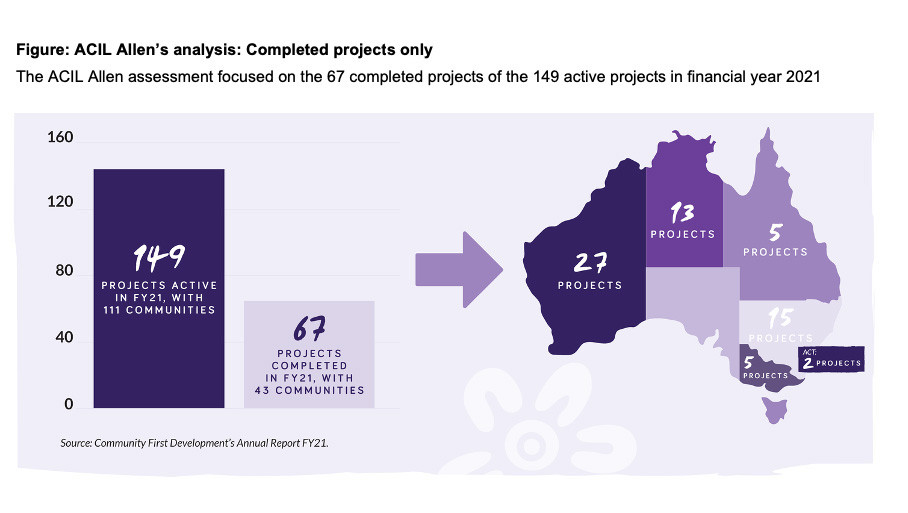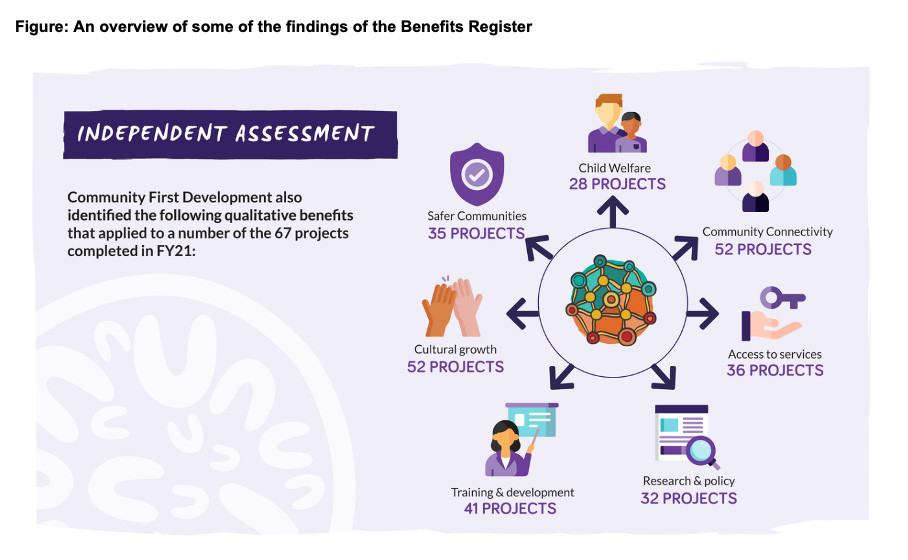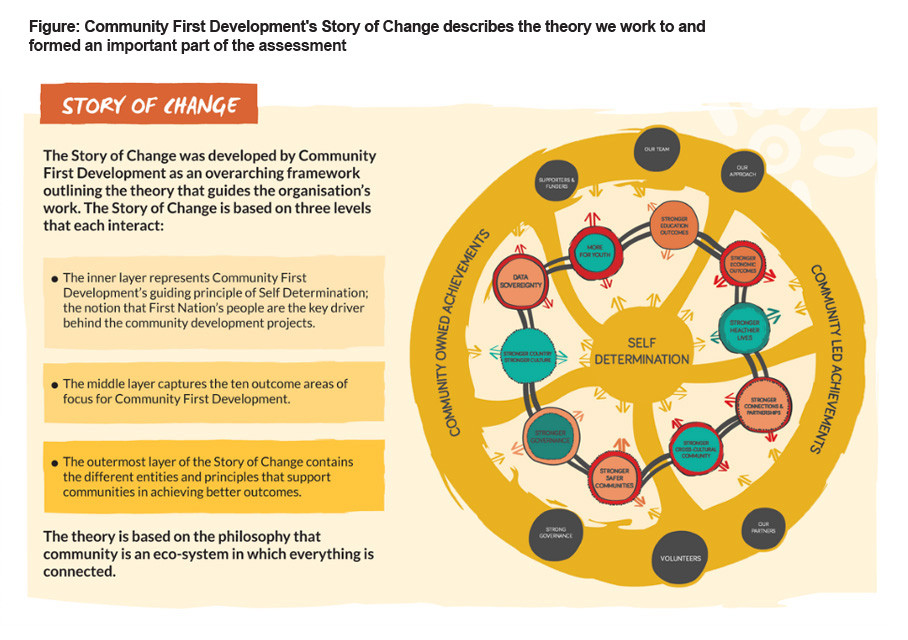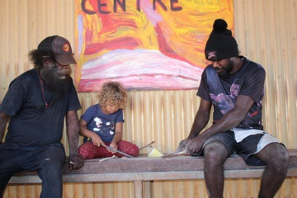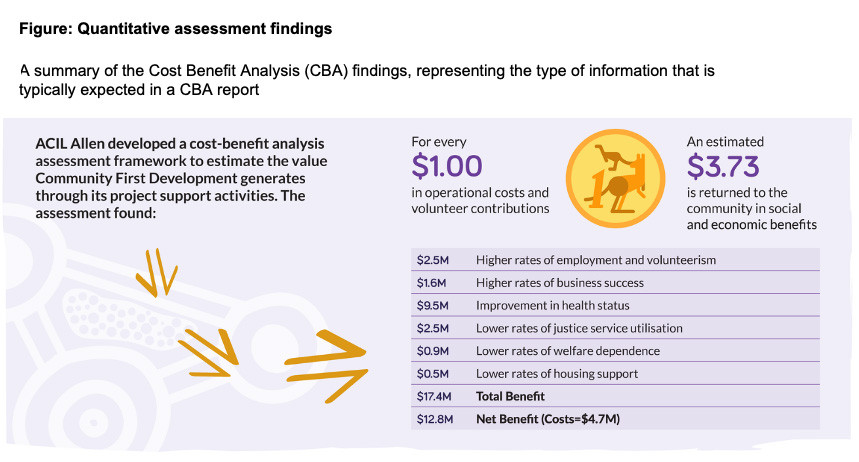Welcome to the AES Blog
Behind the data: A First Nations’ organisation’s experience of a social and economic impact assessment
by Lea Gage and Sharon Babyack, Community First Development
In the second half of 2021, Community First Development took a journey with ACIL Allen (https://acilallen.com.au/) to undertake a significant assessment on the effectiveness of the work we do in partnership with First Nations' communities on their community projects.
What does all this mean and why have we written this blog?
As part of our practice at Community First Development, we are reflection centered. This approach ensures that we can stay on track and do things the 'right way.' As a learning organisation it is important that we take time to reflect and share our learnings: what they mean for us, our sector and most importantly the communities we are privileged to partner with. We hope our experience and the innovative approach shared here are useful for evaluators, policy makers and other First Nations' organisations.
What is in the report?
The assessment was a Cost Benefit Analysis (CBA) which is generally focused on quantitative measures and monetary findings to assess effectiveness of a project or organisation. To a lot of people, this may not really sound that exciting! However, we hope Community First Development and ACIL Allen have raised the bar on CBA towards creating a social and economic assessment, weaving in qualitative social elements into the methodology, through a Benefits Register. This type of approach is innovative and delivered incredible insights using Community First Development's qualitative and quantitative data.
Of interest was the holistic approach to this CBA. It allowed us to focus on the strengths of our model (community-led development), all while looking at its value from a different perspective. The findings of the report show that our community centered approach delivers transformational results. It highlights the importance of genuine partnership with First Nations' communities. Most importantly, the findings in the report support our accountability to our First Nations' community partners – it helps us to reflect and understand where we could be doing better and invest more in what is working. The analysis has provided a baseline to inform future impact assessments and learnings on how we can further elevate and privilege First Nations' voices in these types of assessments.
Hold on – what is a Benefits Register?
ACIL Allen created a Benefits Register for Community First Development to complete, this was to help quantify community projects and the ripple on effect they have on communities.
A number of Community First Development's team collectively worked around the clock for several weeks to explore what these benefits meant, not just for Community First Development purposes, but to uphold appropriate representative integrity to the communities we work with.
The register broke down in detail the areas of employment, business, health, justice, welfare, and housing benefits in the last financial year. This was a tricky exercise to complete, as a lot of reflection, deep thinking and negotiation between staff was required to reach an agreed 'benefit' for each of the communities assessed.
Like many other NGOs and ACCOs, Community First Development does not usually collect data on quantitative measures such as employment opportunities generated per project. In order to track this data, we had to apply secondary metrics, including importance and confidence measures.
For a lot of staff, this exercise was challenging as it was a change in thinking in terms of estimating the potential outcomes in working alongside First Nations' communities. However, it has been a game changer for us to explore new ways to think about the significant impact of the connection with our communities and the trust we have built with them, adding not only benefit to the report findings, but our organisational strength as a First Nations' organisation.
Defining categories and attribution
In all our work at Community First Development we uphold and privilege First Nations' people's right to self-determination and to care for Country. In the assessment process, we unearthed significant questions around terminology (for example what is considered a 'health benefit'?). This led to an important yarning session to define this term for the purpose of the assessment. As part of this session, we also had to decide the key categories to be assessed — also a challenge — but one we are familiar with as we have gone on the journey of strengthening our evaluation capacity to improve our aggregate data collation.
Another challenge in the data collection process was to think about outcomes likely realised in the absence of Community First Development. This resulted in some sobering discussions about the challenges that many First Nations' communities face. Our team are keenly aware that there are always barriers and impediments impacting the progress of communities in reaching their potential and vision.
As part of the process, the team also explored their role within communities and their relationships to other stakeholders and partners. The team reiterated something we often discuss, that Community First Development's contribution to a community's dream forms just one part of the picture. This is reflected in our Story of Change – Community First Development is one part in a community's wider ecosystem.
Too easy, were there any challenges?
It is vital that adequate time is allowed to undertake assessments such as this in First Nations' contexts. The challenge for the team was to 'think big picture,' and create assumptions based on what information we did have about projects and the value of each project.
Through the process we were able to amplify First Nations' communities' voices by advocating for what was important and what is valued by communities. This was based on much time invested in the relationships we have with the communities that formed part of the assessment. In some cases, these are relationships that have been fostered over many years. The Benefits Register was essentially created and connected to the narrative of these relationships.
The importance of yarning and reflecting should not be underestimated. While Community First Development always values yarning and participatory action (as demonstrated in our Action Research Reports https://www.communityfirstdevelopment.org.au/stories/action-research-final-project), the quantification of benefits was a challenging learning curve and one we undertook within a limited timeframe.
For those seeking to undertake an exercise in the future, we would recommend allowing significant time to develop the measures of the Benefits Register in collaboration with community members.
As an organisation, we have had a lot of exposure to Western evaluation methods. Over time, we have developed an understanding of the flexibility and resilience to trial and discuss different approaches that don't always naturally 'fit'. This is our first in depth look at CBAs and we can see a lot of benefits, as well as the potential to explore this further through our First Nations' lens.
What could our future 'ideal world' look like as evaluators in First Nations' contexts?
In future, evaluators looking to complete social and economic impact assessments with First Nations' communities may be interested to explore this through participatory action research approaches.
On reflection one aspect that would have added to the complexity — but certainly added to the value of the findings — was the inclusion of the benefits to language, culture and caring for Country. Despite these being integral to First Nations' individuals and communities, this would have required deep community consultation and further data analysis that were not in the project scope for this baseline report. For example, even though language, culture and caring for Country is now included in the Closing the Gap indicators Dashboard | Closing the Gap Information Repository - Productivity Commission (pc.gov.au), language and culture data is still largely unexplored and arguably undervalued.
Exploring the benefits of language and culture, and caring for Country, in greater detail would speak to what First Nations' communities hold as important. It would also demonstrate the economic value these fundamental pillars have in supporting community development and respecting First Nations' sovereignty.
These learnings have been critical for us to pause and reflect on the significant impact of the work we do, and how we can explain it in different ways for different audiences. The challenges we worked through have been critical points of insight to strengthen the way we communicate about findings in future reports.
We see this report as part of a bigger narrative of the strength of First Nations' communities. We hope it proves to be a source of evidence in guiding decisions towards greater recognition and respect for First Nations people.
What was the outcome?
As governments and major funders were the intended audience for the report, we can deem it a success! The report has been invaluable for communicating with our government audiences and has assisted them to understand the value of what we do using different terms and language.
Our team were thrilled to see the results of the report*: an estimated return of $3.73 in health, social and economic benefits for every $1.00 of contributions invested. After removing operating costs, ACIL Allen estimates the organisation, consisting of 31 staff, delivered an estimated $12.8 million in employment, business, health, justice, welfare, and housing benefits in the last financial year.
From a First Nations' led organisation perspective, this means more than just words on a page. We see this assessment as another much-needed validation of First Nations' successes.
For us, we know that working within a First Nations' cultural framework is the 'right way.' Community First Development recognises that improving the economic outcomes of First Nations' communities leads to direct and flow-on economic benefits including better outcomes in the areas of health, justice, and education.
"For a small not-for-profit organisation, we are punching above our weight. We are delighted by the findings of this report. It demonstrates that community-led development approaches work and that there is high demand and a strong argument for extending this type of support to more communities." Community First Development's CEO Stephanie Harvey (2021)
We have some questions for you!
Do you think there is a way, or a place, to assign a value to the social indicators that we chose to tackle? We'd love to think more about measuring the fiscal benefit of language and culture and caring for Country. How would you go about measuring this?
We welcome questions and conversations about our important work.
Read a summary of the findings and download the full report on our website: www.communityfirstdevelopment.org.au/impactstatement
*Note: The expert analysis completed by ACIL Allen also included Community First Development's financial information and volunteer data and considered population level data. The Benefits Register was only one data source contribution.
----------------------
Lea Gage
Email
Sharon Babyack
Email:
We acknowledge the Australian Aboriginal and Torres Strait Islander peoples of this nation. We acknowledge the Traditional Custodians of the lands in which we conduct our business. We pay our respects to ancestors and Elders, past and present. We are committed to honouring Australian Aboriginal and Torres Strait Islander peoples’ unique cultural and spiritual relationships to the land, waters and seas and their rich contribution to society.


